NRSG140 Clinical Reflection: Mastering Vital Signs & Patient Care
VerifiedAdded on 2023/06/03
|5
|1141
|359
Report
AI Summary
This report is a clinical reflection by a nursing student on obtaining vital signs from patients during a NRSG140 practical class, utilizing Gibbs' reflective cycle. The reflection covers the student's experience with a patient named Ashley Thompson, including initial feelings of worry and confusion, followed by growing confidence. The student details the assessment process, including nutrition assessment and vital signs measurement, while acknowledging mistakes made and lessons learned, such as the correct technique for taking a pulse. The reflection also evaluates the experience, analyzes it in relation to NMBA standards, and outlines an action plan for future improvements, including establishing better patient rapport and adhering to nursing protocols. The student emphasizes the importance of self-confidence, continuous skills development, and self-reflection for accurate assessments and effective nursing interventions.
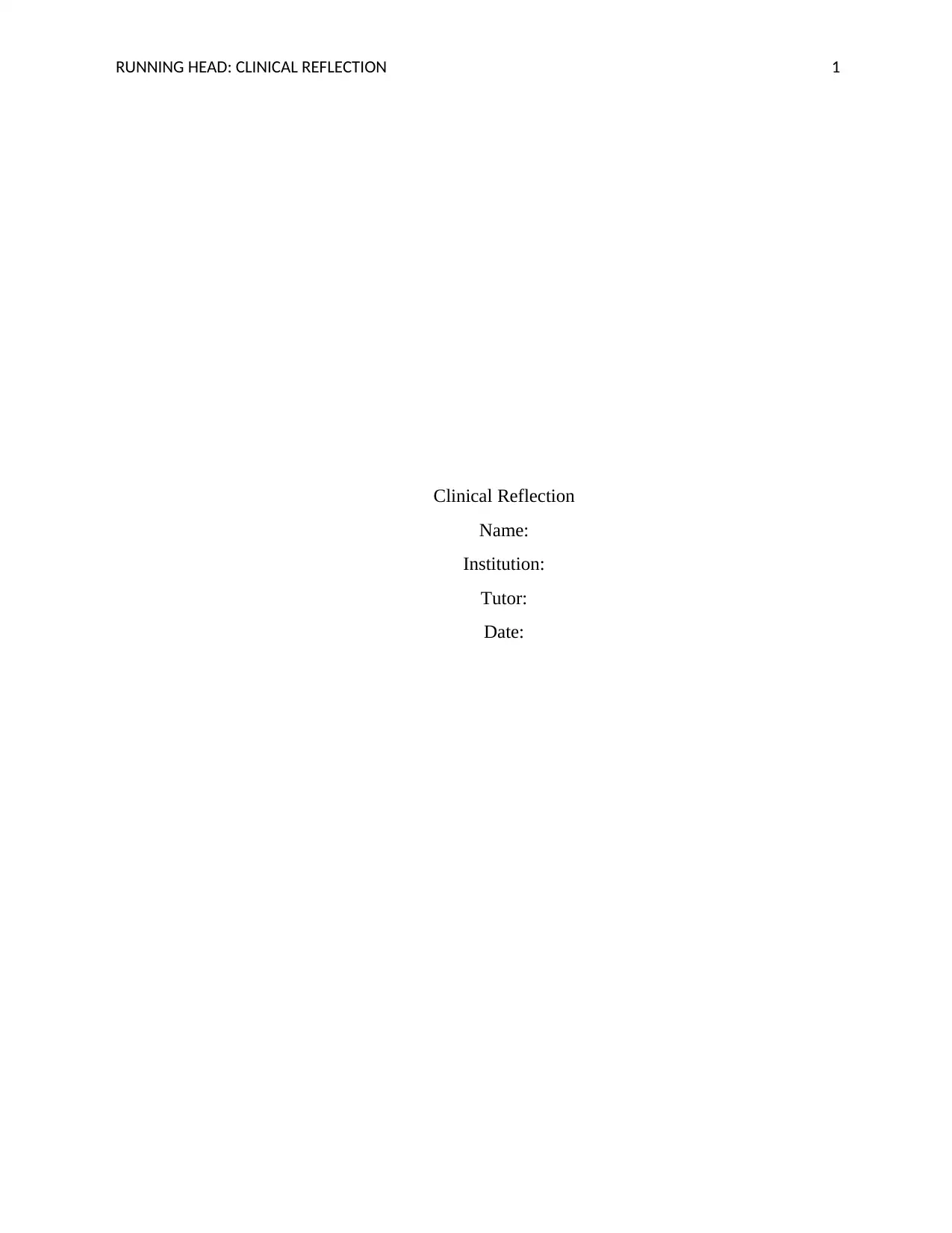
RUNNING HEAD: CLINICAL REFLECTION 1
Clinical Reflection
Name:
Institution:
Tutor:
Date:
Clinical Reflection
Name:
Institution:
Tutor:
Date:
Paraphrase This Document
Need a fresh take? Get an instant paraphrase of this document with our AI Paraphraser
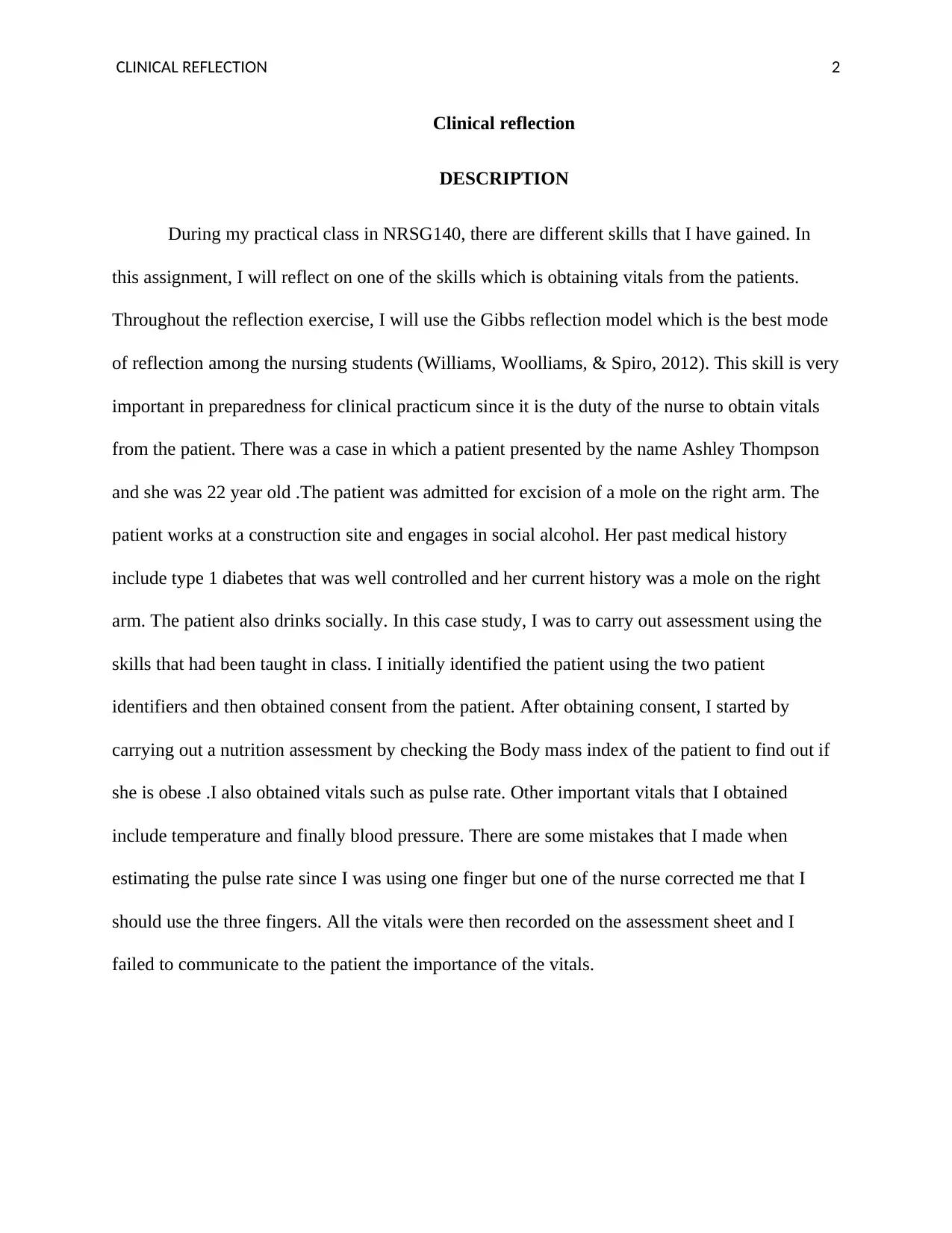
CLINICAL REFLECTION 2
Clinical reflection
DESCRIPTION
During my practical class in NRSG140, there are different skills that I have gained. In
this assignment, I will reflect on one of the skills which is obtaining vitals from the patients.
Throughout the reflection exercise, I will use the Gibbs reflection model which is the best mode
of reflection among the nursing students (Williams, Woolliams, & Spiro, 2012). This skill is very
important in preparedness for clinical practicum since it is the duty of the nurse to obtain vitals
from the patient. There was a case in which a patient presented by the name Ashley Thompson
and she was 22 year old .The patient was admitted for excision of a mole on the right arm. The
patient works at a construction site and engages in social alcohol. Her past medical history
include type 1 diabetes that was well controlled and her current history was a mole on the right
arm. The patient also drinks socially. In this case study, I was to carry out assessment using the
skills that had been taught in class. I initially identified the patient using the two patient
identifiers and then obtained consent from the patient. After obtaining consent, I started by
carrying out a nutrition assessment by checking the Body mass index of the patient to find out if
she is obese .I also obtained vitals such as pulse rate. Other important vitals that I obtained
include temperature and finally blood pressure. There are some mistakes that I made when
estimating the pulse rate since I was using one finger but one of the nurse corrected me that I
should use the three fingers. All the vitals were then recorded on the assessment sheet and I
failed to communicate to the patient the importance of the vitals.
Clinical reflection
DESCRIPTION
During my practical class in NRSG140, there are different skills that I have gained. In
this assignment, I will reflect on one of the skills which is obtaining vitals from the patients.
Throughout the reflection exercise, I will use the Gibbs reflection model which is the best mode
of reflection among the nursing students (Williams, Woolliams, & Spiro, 2012). This skill is very
important in preparedness for clinical practicum since it is the duty of the nurse to obtain vitals
from the patient. There was a case in which a patient presented by the name Ashley Thompson
and she was 22 year old .The patient was admitted for excision of a mole on the right arm. The
patient works at a construction site and engages in social alcohol. Her past medical history
include type 1 diabetes that was well controlled and her current history was a mole on the right
arm. The patient also drinks socially. In this case study, I was to carry out assessment using the
skills that had been taught in class. I initially identified the patient using the two patient
identifiers and then obtained consent from the patient. After obtaining consent, I started by
carrying out a nutrition assessment by checking the Body mass index of the patient to find out if
she is obese .I also obtained vitals such as pulse rate. Other important vitals that I obtained
include temperature and finally blood pressure. There are some mistakes that I made when
estimating the pulse rate since I was using one finger but one of the nurse corrected me that I
should use the three fingers. All the vitals were then recorded on the assessment sheet and I
failed to communicate to the patient the importance of the vitals.
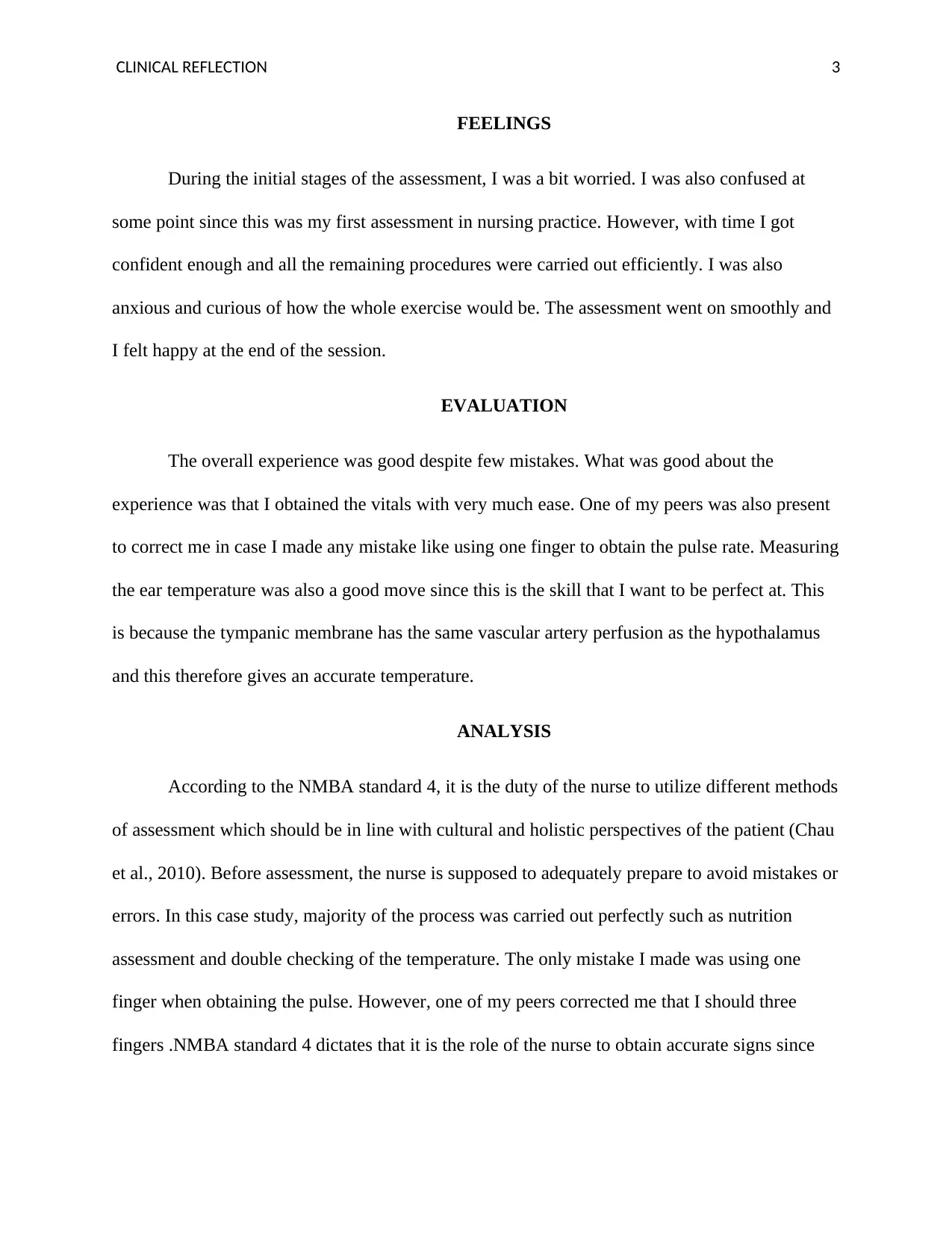
CLINICAL REFLECTION 3
FEELINGS
During the initial stages of the assessment, I was a bit worried. I was also confused at
some point since this was my first assessment in nursing practice. However, with time I got
confident enough and all the remaining procedures were carried out efficiently. I was also
anxious and curious of how the whole exercise would be. The assessment went on smoothly and
I felt happy at the end of the session.
EVALUATION
The overall experience was good despite few mistakes. What was good about the
experience was that I obtained the vitals with very much ease. One of my peers was also present
to correct me in case I made any mistake like using one finger to obtain the pulse rate. Measuring
the ear temperature was also a good move since this is the skill that I want to be perfect at. This
is because the tympanic membrane has the same vascular artery perfusion as the hypothalamus
and this therefore gives an accurate temperature.
ANALYSIS
According to the NMBA standard 4, it is the duty of the nurse to utilize different methods
of assessment which should be in line with cultural and holistic perspectives of the patient (Chau
et al., 2010). Before assessment, the nurse is supposed to adequately prepare to avoid mistakes or
errors. In this case study, majority of the process was carried out perfectly such as nutrition
assessment and double checking of the temperature. The only mistake I made was using one
finger when obtaining the pulse. However, one of my peers corrected me that I should three
fingers .NMBA standard 4 dictates that it is the role of the nurse to obtain accurate signs since
FEELINGS
During the initial stages of the assessment, I was a bit worried. I was also confused at
some point since this was my first assessment in nursing practice. However, with time I got
confident enough and all the remaining procedures were carried out efficiently. I was also
anxious and curious of how the whole exercise would be. The assessment went on smoothly and
I felt happy at the end of the session.
EVALUATION
The overall experience was good despite few mistakes. What was good about the
experience was that I obtained the vitals with very much ease. One of my peers was also present
to correct me in case I made any mistake like using one finger to obtain the pulse rate. Measuring
the ear temperature was also a good move since this is the skill that I want to be perfect at. This
is because the tympanic membrane has the same vascular artery perfusion as the hypothalamus
and this therefore gives an accurate temperature.
ANALYSIS
According to the NMBA standard 4, it is the duty of the nurse to utilize different methods
of assessment which should be in line with cultural and holistic perspectives of the patient (Chau
et al., 2010). Before assessment, the nurse is supposed to adequately prepare to avoid mistakes or
errors. In this case study, majority of the process was carried out perfectly such as nutrition
assessment and double checking of the temperature. The only mistake I made was using one
finger when obtaining the pulse. However, one of my peers corrected me that I should three
fingers .NMBA standard 4 dictates that it is the role of the nurse to obtain accurate signs since
⊘ This is a preview!⊘
Do you want full access?
Subscribe today to unlock all pages.

Trusted by 1+ million students worldwide
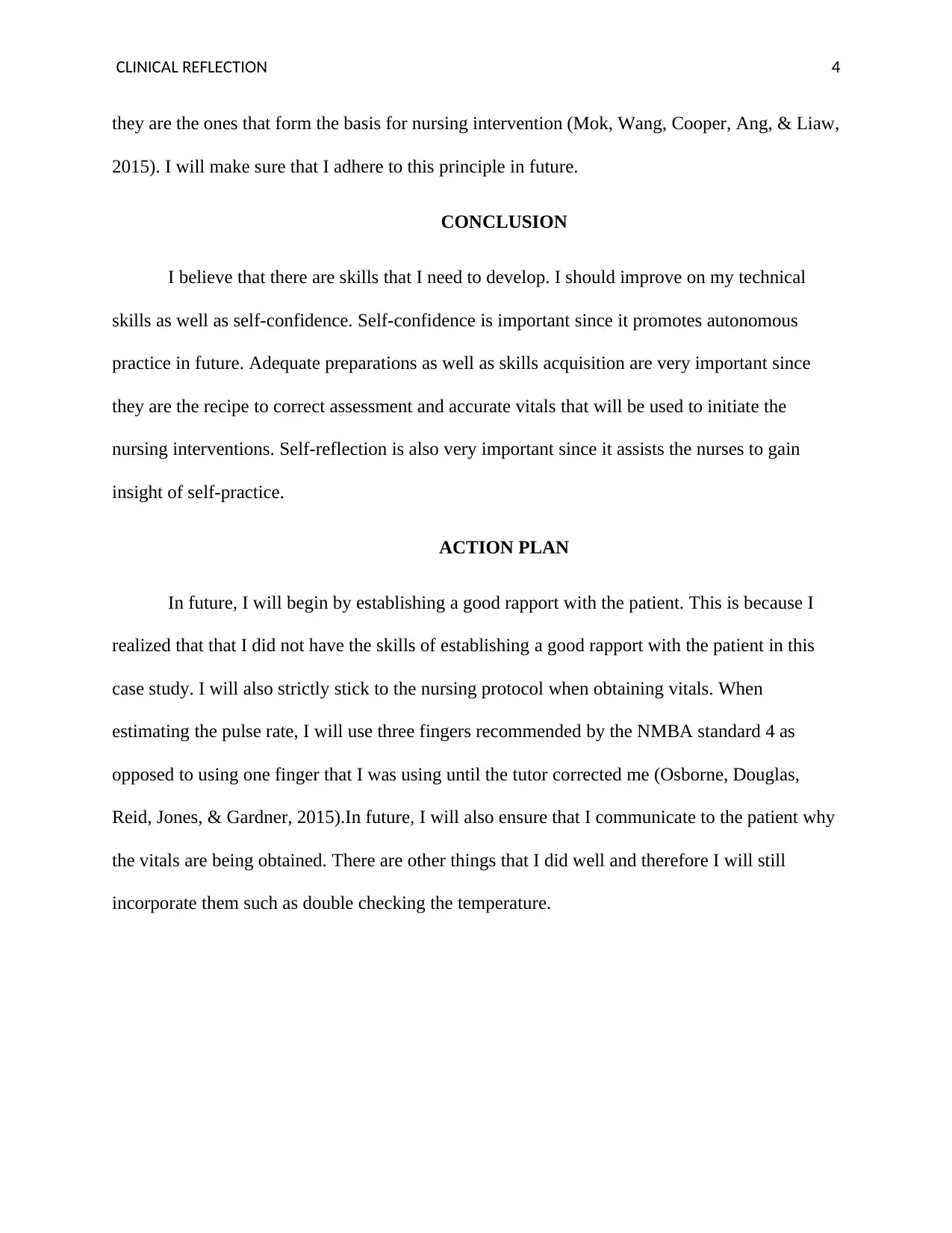
CLINICAL REFLECTION 4
they are the ones that form the basis for nursing intervention (Mok, Wang, Cooper, Ang, & Liaw,
2015). I will make sure that I adhere to this principle in future.
CONCLUSION
I believe that there are skills that I need to develop. I should improve on my technical
skills as well as self-confidence. Self-confidence is important since it promotes autonomous
practice in future. Adequate preparations as well as skills acquisition are very important since
they are the recipe to correct assessment and accurate vitals that will be used to initiate the
nursing interventions. Self-reflection is also very important since it assists the nurses to gain
insight of self-practice.
ACTION PLAN
In future, I will begin by establishing a good rapport with the patient. This is because I
realized that that I did not have the skills of establishing a good rapport with the patient in this
case study. I will also strictly stick to the nursing protocol when obtaining vitals. When
estimating the pulse rate, I will use three fingers recommended by the NMBA standard 4 as
opposed to using one finger that I was using until the tutor corrected me (Osborne, Douglas,
Reid, Jones, & Gardner, 2015).In future, I will also ensure that I communicate to the patient why
the vitals are being obtained. There are other things that I did well and therefore I will still
incorporate them such as double checking the temperature.
they are the ones that form the basis for nursing intervention (Mok, Wang, Cooper, Ang, & Liaw,
2015). I will make sure that I adhere to this principle in future.
CONCLUSION
I believe that there are skills that I need to develop. I should improve on my technical
skills as well as self-confidence. Self-confidence is important since it promotes autonomous
practice in future. Adequate preparations as well as skills acquisition are very important since
they are the recipe to correct assessment and accurate vitals that will be used to initiate the
nursing interventions. Self-reflection is also very important since it assists the nurses to gain
insight of self-practice.
ACTION PLAN
In future, I will begin by establishing a good rapport with the patient. This is because I
realized that that I did not have the skills of establishing a good rapport with the patient in this
case study. I will also strictly stick to the nursing protocol when obtaining vitals. When
estimating the pulse rate, I will use three fingers recommended by the NMBA standard 4 as
opposed to using one finger that I was using until the tutor corrected me (Osborne, Douglas,
Reid, Jones, & Gardner, 2015).In future, I will also ensure that I communicate to the patient why
the vitals are being obtained. There are other things that I did well and therefore I will still
incorporate them such as double checking the temperature.
Paraphrase This Document
Need a fresh take? Get an instant paraphrase of this document with our AI Paraphraser
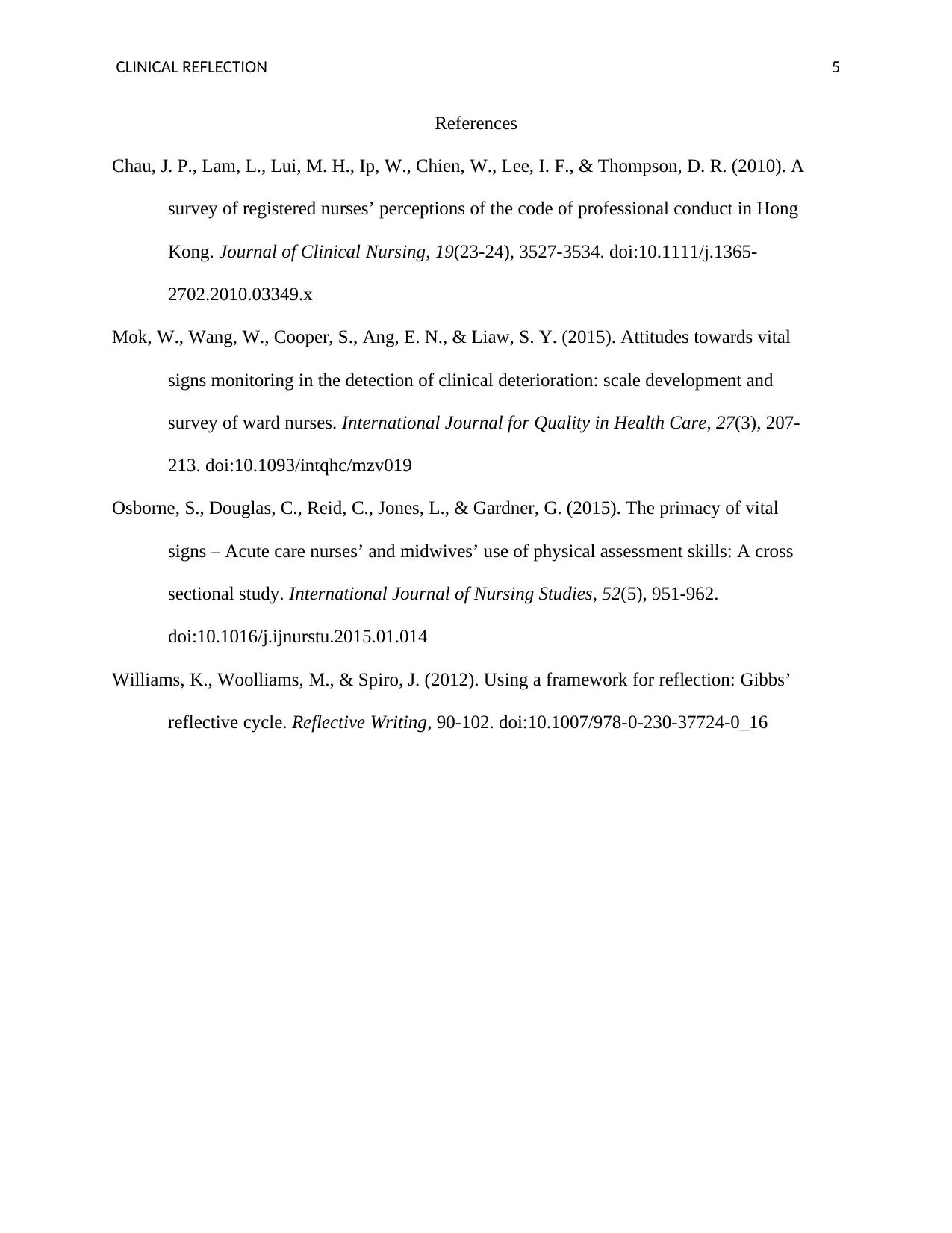
CLINICAL REFLECTION 5
References
Chau, J. P., Lam, L., Lui, M. H., Ip, W., Chien, W., Lee, I. F., & Thompson, D. R. (2010). A
survey of registered nurses’ perceptions of the code of professional conduct in Hong
Kong. Journal of Clinical Nursing, 19(23-24), 3527-3534. doi:10.1111/j.1365-
2702.2010.03349.x
Mok, W., Wang, W., Cooper, S., Ang, E. N., & Liaw, S. Y. (2015). Attitudes towards vital
signs monitoring in the detection of clinical deterioration: scale development and
survey of ward nurses. International Journal for Quality in Health Care, 27(3), 207-
213. doi:10.1093/intqhc/mzv019
Osborne, S., Douglas, C., Reid, C., Jones, L., & Gardner, G. (2015). The primacy of vital
signs – Acute care nurses’ and midwives’ use of physical assessment skills: A cross
sectional study. International Journal of Nursing Studies, 52(5), 951-962.
doi:10.1016/j.ijnurstu.2015.01.014
Williams, K., Woolliams, M., & Spiro, J. (2012). Using a framework for reflection: Gibbs’
reflective cycle. Reflective Writing, 90-102. doi:10.1007/978-0-230-37724-0_16
References
Chau, J. P., Lam, L., Lui, M. H., Ip, W., Chien, W., Lee, I. F., & Thompson, D. R. (2010). A
survey of registered nurses’ perceptions of the code of professional conduct in Hong
Kong. Journal of Clinical Nursing, 19(23-24), 3527-3534. doi:10.1111/j.1365-
2702.2010.03349.x
Mok, W., Wang, W., Cooper, S., Ang, E. N., & Liaw, S. Y. (2015). Attitudes towards vital
signs monitoring in the detection of clinical deterioration: scale development and
survey of ward nurses. International Journal for Quality in Health Care, 27(3), 207-
213. doi:10.1093/intqhc/mzv019
Osborne, S., Douglas, C., Reid, C., Jones, L., & Gardner, G. (2015). The primacy of vital
signs – Acute care nurses’ and midwives’ use of physical assessment skills: A cross
sectional study. International Journal of Nursing Studies, 52(5), 951-962.
doi:10.1016/j.ijnurstu.2015.01.014
Williams, K., Woolliams, M., & Spiro, J. (2012). Using a framework for reflection: Gibbs’
reflective cycle. Reflective Writing, 90-102. doi:10.1007/978-0-230-37724-0_16
1 out of 5
Related Documents
Your All-in-One AI-Powered Toolkit for Academic Success.
+13062052269
info@desklib.com
Available 24*7 on WhatsApp / Email
![[object Object]](/_next/static/media/star-bottom.7253800d.svg)
Unlock your academic potential
Copyright © 2020–2025 A2Z Services. All Rights Reserved. Developed and managed by ZUCOL.





